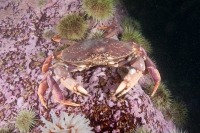
(Photo: Andrew J. Martinez)
Atlantic Rock Crab
Cancer irroratus
Yellow-brown crab with many purple or crimson dots on its back. Broad oval carapace (shell) with nine shallow, smooth-edged teeth along the front of each side. The carapace grows up to 15 centimetres across.
Authority
Say, 1817
Classification Details
Phylum: Arthropoda (arthropods); Subphylum: Crustacea (crustaceans).
Habitat
Found on most types of seabed. Smaller crabs under 50 millimetres are usually found on rock, whereas larger ones tend to live on sand or mud seabeds. Found on Atlantic coasts from Newfoundland to South Carolina, down to over 700 metres. In Canada, it is most common in depths of 5 to 20 metres.
Diet
Eat live prey, including worms, clams, mussels, and other crabs. Also scavenge on dead animals. Grab prey with their large front claws before chewing it up with their mouthparts.
Reproduction
Rock crabs can be male or female. Males mate with females, transferring sperm using modified legs. The female lays her eggs several days after mating. She stores the eggs on her abdomen under her tail for almost a year. A female can lay over 500 000 eggs at a time. The eggs eventually hatch into plankton-feeding larvae that swim for up to two months before they change into small crabs. Rock crabs live for around eight years.
Fun Facts
You might sometimes see a male crab carrying a female. Rock crabs can only mate while the female’s carapace is soft, following moulting. Males and females use chemicals called pheromones to find each other. Then the male wraps his legs and claws around the female and takes her in a pre-mating embrace. After several days the female will moult, and mating occurs. After mating, the male keeps the female in an embrace to protect her from predators.
In Maine, rock crabs are known as peekytoe crabs. This nickname comes from picked toe and refers both to the handpicked leg or toe meat and the pointed shape of the leg (picked means “pointed” in Maine).
References
Bigford TE (1979) Synopsis of biological data on the rock crab, Cancer irroratus Say. NOAA technical report NMFS Circular 426. Pohle GW (1990) A guide to decapod crustacea from the Canadian Atlantic: Anomura and Brachyura. Canadian Technical Report of Fisheries and Aquatic Sciences No. 1771, 30 pp. Squires HJ (1990) Decapod crustacea of the Atlantic coast of Canada. Canadian Bulletin of Fisheries and Aquatic Sciences 221, 532 pp.

